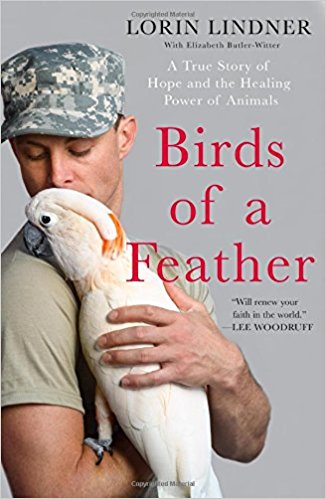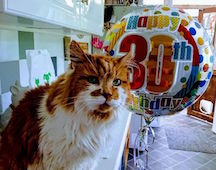Are Americans Too Attached To Their Pets?
Dr. Clay Routledge
 Dr. Clay Routledge is a Psychological Scientist who believes young adults may be bonding with animals at the expense of vital human relationships. While the Animal Radio team may be divided on the health aspects of loving your pet "too much," there is one empirical fact; some of us have trouble prioritizing humans over animals.
Dr. Clay Routledge is a Psychological Scientist who believes young adults may be bonding with animals at the expense of vital human relationships. While the Animal Radio team may be divided on the health aspects of loving your pet "too much," there is one empirical fact; some of us have trouble prioritizing humans over animals.
It's a touchy subject for most animal lovers, and Dr. Routledge, is one of them. In fact, he tells us it is a general rule in his family that he is not allowed to go to places in which there's an opportunity for him to bring home an animal because he undoubtedly will.
The issue, according to Dr. Routledge, really isn't do we love our pets too much but what does it say about the human condition that we are so attached to our pets. To him it's more of what it signals about perhaps deficits in other areas than it says anything about what our pets deserve. However, he can certainly speak about some concerns that he thinks we should all share about the risks to animals when treating them more like they have human qualities than they actually do.
Today, millennials are bringing pets into their lives as their children instead of having human babies. Dr. Routledge explains that there's a lot of debate as to why that is the case. Perhaps its issues ranging from the economic costs associated with children, to people being too busy. But there is some interesting research relating issues like loneliness to pet ownership. There are also trends related to the delaying of marriage and having children. These things seem to correspond with increased pet ownership and not just people having pets, but the anthropomorphism where they treat things or animals that aren't humans, as if they have human cognitive qualities.
Examples of this is where people put their dogs in baby strollers when they aren't injured in any way and when the dog would be better of walking. People also feed their dogs human food that's not necessarily best for their nutritional needs.
Dr. Routledge also tells us this really insane new trend for millennial hipsters to not vaccinate their dogs. This speaks to two crazy beliefs. First, they believe in the false idea that vaccinations cause autism and two, they think that their dogs can even get autism.
These kinds of trends don't necessarily show some kind of bad state that we're in as a social species, but that there are some real risks to animals. There are some real risks to neglect and abuse of treating animals not like animals, but like they're fully part of the human species.
 Where do you draw the line between being over the top with your pet and just being a regular pet owner? Dr. Routledge feels that most pet owners have a perfectly healthy relationship with their pets. However, he thinks people need to be educated about what they can expect from an animal.
Where do you draw the line between being over the top with your pet and just being a regular pet owner? Dr. Routledge feels that most pet owners have a perfectly healthy relationship with their pets. However, he thinks people need to be educated about what they can expect from an animal.
People are less likely across urban, rural and suburban areas of our country, to feel strongly attached to their community. They're less likely to feel like there are people that they can confide in. So he thinks what we're seeing on some level, and of course there's plenty of people that have perfectly healthy relationships with their pets and he's not talking about them here, but at some level there's something going on in which people are so desperate for that human connection that they're elevating their dogs by expecting more from them than they really can give.
When we use animals for emotional support, is that crossing the line? Dr. Routledge states it's complicated because there is certainly work that suggests that animals are an excellent source of comfort. There's work with elderly people for instance, who might be widowed or living alone or have disability issues that make it hard for them to get out there and living in assisted living facilities, where having a dog can make the difference between feeling depressed or feeling like you've got a purpose. It's certainly the case that pets are comforting and that's fine, but that's a different issue than whether or not they have a scientifically established clinical effectiveness. There just really isn't much evidence showing that you need to take an emotional animal support animal with you in order to be psychologically functional.
So are people replacing human interaction with their pets, and if so, why is that happening? Dr. Routledge feels that one unfortunate component to this loneliness problem or the social disconnection problem is that it kind of perpetuates itself. When people feel lonely or excluded or ostracized, their brain kind of switches to a more defensive position in which they become extremely vigilant about further social loss and they don't want to get hurt again. They don't want to be rejected again. What that can make them do is take fewer social risks. So they're less likely to go out and want to meet people. They're more avoidant. And so if they're directing that social energy trying to meet their social needs with their pets, then that's an easier and safer way to try to meet their belongingness needs than to have to actually go out and deal with human beings.
Libraries are now bringing children and dogs together by letting the children read aloud to the dogs because the dog won't criticize them or tell them that they're reading poorly. That seems to be what we find in all of our animals is that they're nonjudgmental and it's very easy to make them your best friend.
 Dr. Routledge explains that there was some research a couple decades ago in psychology about a concept called contingencies of self worth. The idea was that people's sense of self-esteem or people's sense of self confidence comes in part from the contingencies other people put on them and what have to do to be accepted by others. Interestingly, this was one of the arguments that was made for the positivity of religion. What makes religion so comforting is this sense that God loves you no matter what. Dr. Routledge is not trying to compare pets to God by any means, but you can get that kind of sense that you feel that these animals love you no matter what. There's something very affirming about that when you have to go out in the world and deal with people who may only like you conditionally or only reinforce you conditionally.
Dr. Routledge explains that there was some research a couple decades ago in psychology about a concept called contingencies of self worth. The idea was that people's sense of self-esteem or people's sense of self confidence comes in part from the contingencies other people put on them and what have to do to be accepted by others. Interestingly, this was one of the arguments that was made for the positivity of religion. What makes religion so comforting is this sense that God loves you no matter what. Dr. Routledge is not trying to compare pets to God by any means, but you can get that kind of sense that you feel that these animals love you no matter what. There's something very affirming about that when you have to go out in the world and deal with people who may only like you conditionally or only reinforce you conditionally.
After writing his article, "Are Americans Too Attached To Their Pets?" Dr. Routledge received dozens and dozens of hate emails essentially confirming that people have only been treated horrible by people; you can't trust people; you can't depend on people; and whenever I come home from work, my dog is always happy to see me. This was fascinating to him because so much of it stated that humans are trash, humans are garbage and that he was also garbage. In a way, it just spoke to his point that people don't have a lot of faith in humanity, with poll numbers supporting this. So this kind of reinforcement, which again there's nothing wrong with being happy to see your dog, but the questions we have to ask is, what is that? Is that indicating something that's missing in terms of human relationships?
Visit Website
Parrots Help Veterans with PTSD
Dr. Lorin Lindner, Birds of a Feather
 Dr. Lorin Lindner founded Serenity Park, a unique sanctuary on the grounds of the Los Angeles Veterans Administration Healthcare Center. She noticed that the veterans she treated as a clinical psychologist and the parrots she had taken in as a rescuer quickly formed bonds. Men and women who had been silent in therapy would share their stories and their feelings more easily with animals.
Dr. Lorin Lindner founded Serenity Park, a unique sanctuary on the grounds of the Los Angeles Veterans Administration Healthcare Center. She noticed that the veterans she treated as a clinical psychologist and the parrots she had taken in as a rescuer quickly formed bonds. Men and women who had been silent in therapy would share their stories and their feelings more easily with animals.
Dr. Lorin Lindner tells us that she is owned by more than one bird and never thought about using them for veterans suffering from PTSD (Post-Traumatic Stress Disorder). It all started when she was trying to do group therapy with a menagerie of veterans who were sitting with their arms crossed, not wanting anything to do with her. She had brought one of her birds to the therapy room just really as a convenience because she had nowhere else to put her. Her bird then climbed down to the floor and climbed up one of the veteran's legs and said, "Hewo, I Wuv You!" She explained that that got in a lot better than she did. This was all a happy accident, which led to many more.
Dr. Lindner is a clinical director of a program for homeless veterans and thought that initially the parrots might be a good diversion. Little did she know they were going to be a part of her armamentarium for treating veterans with PTSD. However, it was so successful that she created a sanctuary for veterans and birds, which is the only one in the world.
There are many parrots at Serenity Park, so where did they come from? Unfortunately there is no lack of parrots in need of homes. There's an estimated 30 to 60 million parrots in the United States and are the third most commonly kept companion animal.
 Most of them will outlive their family members so what happens to them when their guardian dies? Family members usually don't want to inherit a bird and deal with the mess and the screaming and the biting. They want to travel or they have young children or they have myriad other reasons why they can't keep a bird for it's long lifetime. Dr. Lindner gets calls every single day. She also receives emails and texts from people who want to relinquish their parrots.
Most of them will outlive their family members so what happens to them when their guardian dies? Family members usually don't want to inherit a bird and deal with the mess and the screaming and the biting. They want to travel or they have young children or they have myriad other reasons why they can't keep a bird for it's long lifetime. Dr. Lindner gets calls every single day. She also receives emails and texts from people who want to relinquish their parrots.
Unfortunately Serenity Park is full at this point and while there are many other sanctuaries in the country, they're close to full as well. Currently Serenity Park has 42 birds. They could build more enclosures, but of course that costs money and it's difficult now with the cost of steel and labor. They do use the veterans to do everything from the animal husbandry to caring for the parrots, to learning the vet tech skills necessary to provide medications when needed. They also use them for the construction of the aviaries that enable the parrots to live a little bit more of a natural life than they would in small cages when their kept in homes.
 Parrots need to have flight, forage and flocking to have a happy life. They also need to be with other members of their own species just like we do. They are social animals and they depend on having other animals of their own kind around them to thrive and to have quality of life. Because of this, it's a very synergistic relationship with the birds helping the veterans and the veterans helping the birds. Dr. Lindner tells us that the birds really do interact with the veterans and they establish deep and lasting relationships because most of the time they mate for life, if humans allow them to. The veterans really form very solid relationships with the birds and that's part of the healing process for the veterans who have been estranged from society after they've returned from military service and they don't feel like they have a place anywhere that they fit in again.
Parrots need to have flight, forage and flocking to have a happy life. They also need to be with other members of their own species just like we do. They are social animals and they depend on having other animals of their own kind around them to thrive and to have quality of life. Because of this, it's a very synergistic relationship with the birds helping the veterans and the veterans helping the birds. Dr. Lindner tells us that the birds really do interact with the veterans and they establish deep and lasting relationships because most of the time they mate for life, if humans allow them to. The veterans really form very solid relationships with the birds and that's part of the healing process for the veterans who have been estranged from society after they've returned from military service and they don't feel like they have a place anywhere that they fit in again.
Being of service to the parrots is really important to the veterans. The parrots also thrive on that kind of attention and really love that interaction. People don't realize how much birds really do indeed enjoy a healthy relationship with humans. Parrots are also are extremely intelligent, and according to Dr. Lindner, equally so to most primates and marine mammals.
Dr. Lindner hopes that people will read her book, Birds of a Feather, and learn about the plight of parrots first of all, because most people don't even know about adopting a parrot. They know about going to adopt a dog and a cat at the shelter and they know about puppy mills. However, there are also bird mills where conditions are just dreadful for these poor parrots and their young. Readers will also learn about the veterans who are suffering from PTSD and are having a hard time readjusting to civilian life and fitting into society and how the two of them together, these sort of "birds of a feather," are relating and healing each other in ways that are really quite extraordinary.
Visit Website
How To Build The Perfect Litter Box - Dr. Debbie
 One sniff upon entering your home and you recognize the unmistakable odor of cat urine and feces. Simba has used your entry hall as his litter box again. But before you lose your temper - stop. By scrutinizing the environment through your cat's eyes, you will likely discover the cause of his toileting mishaps.
One sniff upon entering your home and you recognize the unmistakable odor of cat urine and feces. Simba has used your entry hall as his litter box again. But before you lose your temper - stop. By scrutinizing the environment through your cat's eyes, you will likely discover the cause of his toileting mishaps.
Elimination issues are a main reason for veterinary visits and a primary reason for relinquishment of cats at shelters. House soiling problems can be multi-factorial, with an overlap of behavioral, environmental and medical causes. Feline house soiling can be managed however with sleuth work and patience. The challenge is to think like a cat.
First and foremost, say this and repeat it..."My cat does not eliminate out of the litter box to get even with me." Cats do use urine and fecal scent marks to communicate territory, but this isn't done with spite or in effort to "get even" with you. Inappropriate elimination is a cat's way stating that something isn't right in their world. Understanding this is key before tackling feline house soiling. Focus on what's wrong in Simba's toilet area, not on how the house soiling makes you feel.
Start With a Vet Check
Cat owners often struggle with house soiling mishaps for months or years before enlisting help from their veterinarian. But seeing the veterinarian should be the first step, since health disorders may be at the root of some house soiling issues. Your efforts in restoring litter box usage will be doomed if an underlying medical cause is not addressed at the same time.
Size Does Matter
Make sure your cat's litter box is of adequate size to allow maneuvering. Litter box size should be 1 ½ times the length of cat's body length. Height of the edge also matters. For older kitties, try lower profile litter boxes or plastic under bed storage boxes. An arthritic older cat won't complain or cry in pain with arthritis, she'll just chose to eliminate elsewhere.
Consider the View
Cats don't want to be startled while in the loo. Don't place the litter box in a high traffic area where people and pets are always a-coming and going. Cats prefer a low traffic area where they can have an eye out on things.
Don't place the litter box near appliances which give off noise, vibration and heat, all which disturb your cat while eliminating. Once a negative aversion is created, your cat may not return to use that box in the future.
 Ditch the Litter Box Cover
Ditch the Litter Box Cover
While some nervous kitties prefer the privacy of litter box covers, the majority of cats dislike the tight quarters and limited ventilation litter box covers provide. Consider how you feel in a public porta-potty. Do you like to touch the walls when inside? Sure, people like the way the lid contains odors, but does it really matter how little odor comes from the litter box when your cat is pooping on your oriental rug?
Provide More Than One Box
A common error is assuming that one litter box is all your cat needs. What cat owner loves the litter box, and relishes seeing more of them in the home? But the more the better when it comes to faithful litter box usage, especially with multiple cats. The general rule is to provide one more box than the number of cats. Some cats share litter boxes, others will not. Unless you provide alternate sites you may have elimination issues in multiple cat homes.
Another special consideration is differences in cat's personalities - timid cats may avoid crossing paths with other more assertive pets in home. Be sure to provide litter box sites that won't be blocked by other animal's movements.
If you live in a multilevel home - you must provide litter box sites on each level. This is especially important in multi-cat homes, those with senior cats or those with health conditions.
The Pick of Litters
Litter texture preferences vary and there are many choices from scoopable, clay, crystals, or natural litters. However in one research study of cat's litter box habits, it demonstrated that the majority of cats prefer fine grained scoopable clay based litters that have carbon as their odor absorbing ingredient. Every cat is different though, so try other litter varieties until you find your cat's preference.
Skip the Scents
The verdict is still out on what odors cats prefer, but avoid heavily scented litters or deodorizers if your cat is missing the box. Interestingly enough, one study showed cats preferred cedar and fish odors, while avoiding citrus and floral scents, while another study concluded cats preferred fish or bleach smells to other scents.
Kitty Litter Depth
Ideal litter depth is 2 inches - more isn't always better. Some cats thrive on scratching the bottom of the pan, which is obscured by excessive amounts of litter.
Keep It Clean
Cats are fastidious by nature and will avoid using a soiled or smelly box. The overall cleaning frequency depends on the number of cats in the home. General advice is to scoop twice a day and deep clean the litter pan weekly. Change out clumping litter every 2-3 weeks.
Build It and Kitty Will Use It
By building your cat's dream litter box, your cat will find litter box nirvana. And you'll come to enjoy a better relationship with your kitty family members without those unwanted "presents" in the foyer.
Featured veterinarian known as "Dr. Debbie" on national pet radio program, Animal Radio. Ebook author of "Yorkshire Terriers: How to Be Your Dog's Best Friend"; "Pugs: How to Be Your Dog's Best Friend"; "Mini Schnauzers: How to Be Your Dog's Best Friend"; and "Shih Tzu: How to Be Your Dog's Best Friend." Dr. Debbie's books.
Visit Website
Animal Radio News - Lori Brooks
 Filthy Pet Food Production Facility
Filthy Pet Food Production Facility
Mars Company, which markets canned dog and cat foods under the Pedigree, Cesar, Whiskas, Nutro and IAMS brands, had problems at their pet food production facility in Columbus, OH, which became public. Food Safety News.com revealed that the facility was crawling with an infestation of German cockroaches in 2016 and 2017. Pet food from the plant also generated consumer complaints about finding hard plastic pieces in the pet food. A recall of the affected foods was issued, but inspections of the facility to check on how they remedied the problem found the company had not completed repairs as promised. During an inspection last July, investigators from the FDA found two more problems: one having to do with how raw ingredients were handled and another citation found the plant had failed to take effective measures against contamination of animal food by pests. That report specifically showed employees at the Mars facility had reported birds, beetles and multiple flies, even maggots in areas where raw ingredients were stored and handled. You would think once inspectors find these problems that companies would be eager to fix the problems and get a clean record again, but that's not always the case. In the report of how Mars dealt with follow up inspections, FDA investigators reported Mars officials refusing to cooperate on three points three during the course of the inspection, including: refusal to permit any pictures to be taken and refusal to provide photocopies of consumer complaints and pest control records. The investigation triggered by that initial recall is now closed.
 World's Oldest Cat
World's Oldest Cat
After been given the title of the oldest cat in the world, Rubble, a fluffy Maine Coone, passed away at the age of 31 years in May of last year. The age of 31 years for a cat is the equivalent of almost 150 in human years. Rubble had been with his mom since she got him as a kitten on her 20th birthday in May of 1988. They had been inseparable and Rubble has now matched the age of the last world record holder. The oldest cat ever according to the record books is Creme Puff who was born on August 3, 1967 and lived until August 6, 2005, an amazing 38 years and 3 days.
Monkey Bites Home Depot Employee
A pet monkey escaped from its owner's truck and went ape on a Home Depot worker in Florida. A domesticated spider monkey named Spanky went wild in the store parking lot after he got loose, then bit a woman who was trying to help capture the creature and get it back to its owner. The woman quietly got the monkey's leash when it crawled up her back where it bit her, twice. When Spanky climbed down off her back, the woman got hold of his leash again and walked him to the front door of the store to look for its owner. When the front sliding glass door of the store opened, the monkey got scared and bit her again on the arm and hand. It was not Spanky's first visit to the store but perhaps it will be the last.
 Rare Lobster Saved From Death Row
Rare Lobster Saved From Death Row
In some cases a genetic defect can be a great thing but it's usually a bad thing when that leads to an unusually colored animal in the wild, because it makes them stand out and become easy prey for predators. In the case of one Canadian lobster, rare pigmentation was a good thing and led recently to a reprieve from death row. The bright orange crustacean arrived from Nova Scotia as part of a shipment mostly filled with crustaceans of the usual greenish-brown color. Workers who saw it at the store, which sells 200,000 lobsters a year, knew they had a rare specimen and donated it to the New England Aquarium in Boston. Experts at the University of Maine's Lobster Institute said the orange color of that lobster occurs in just one of about every 30 million lobsters.
 Listen to the entire Podcast of this show (#1090)
Listen to the entire Podcast of this show (#1090)





